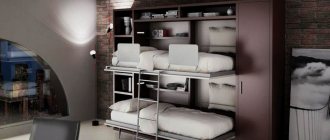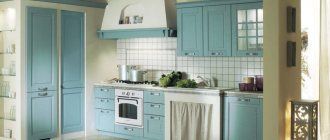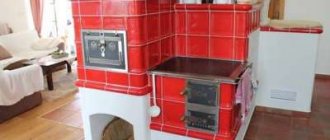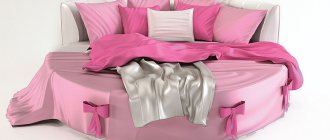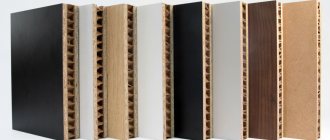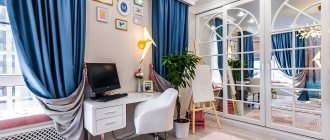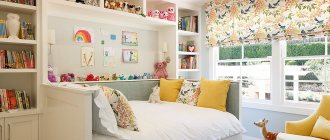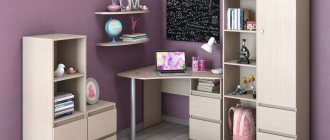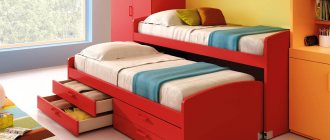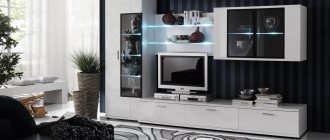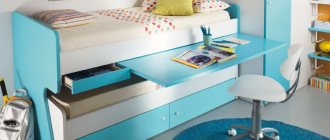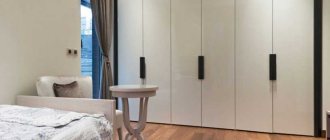<
>
As a rule, furniture buyers focus on the frame and dimensions of the structures, without being interested in what the cabinet front is and what role it plays in the product.
The facade of the cabinet is its front surface, which also includes the design of the doors.
It is the facade that determines the appearance of the structure and allows you to create a unique interior, giving the furniture not only a practical, but also an aesthetic function.
The modern furniture market offers a variety of types of cabinet fronts. This allows you to easily select furniture that will organically fit into the interior of your home.
Basic classification
To choose the best facades for furniture, you need to understand the features of all existing types. They are divided into categories according to the purpose of the room for which the products are intended. Each variety must have certain characteristics.
| Type of room | Qualities that facades should have |
| Kitchen | Resistance to sudden temperature changes and mechanical damage |
| Bathroom | Good tolerance to high humidity |
| Living room | High strength, long service life |
| Bedroom | Comfortable method of operation, appropriate decor |
| Children's | Absolute safety (no harmful chemical compounds in the material, rounded edges) |
| Hallway | Presentable appearance, reliability, durability |
It is important to consider the conditions under which the facades will be used. For example, the mirrored decor of a bedroom set is completely inappropriate in the kitchen, and glass doors in the hallway are inappropriate, but they are ideal for decorating a living room. According to the production method, there are facades:
- Whole. They are blank panels decorated on the front side. They are decorated by pressing or special overlays and wooden elements are used for production. They are made mainly from glass and natural wood.
- Composite (frame-paneled). They have a multilayer structure, are characterized by high strength and lower cost.
In order for the selected furniture facades to last as long as possible and be comfortable to use, it is necessary to take into account many nuances. It is advisable to entrust the selection of these elements to specialists. After all, the facade should not only be of high quality and durable, but also fit perfectly into the interior.
One-piece
Composite
What inserts can be used?
To decorate facades, overlays and inserts made from a variety of materials are often used. They allow you to get exquisite and bright interior items that have no analogues on the market. Framed facades are usually created from MDF, which is the base represented by a frame into which other materials are inserted. The most popular inserts are:
- Tempered glass or mirror surfaces, giving any furniture lightness and sophistication;
- Rattan or bamboo, suitable for unusual interiors in which preference is given to natural materials;
- Plastic, which has a low cost and imitates various unique modern materials;
- Metal, with preference given to forged fragments.
The facades of cabinet furniture are the primary elements on which the appearance of the entire product depends. For their production, different materials, combinations of decorative elements and coatings are used. The shape and dimensions must ideally match the existing furniture, so you need to correctly calculate these indicators in advance. With the right choice of designs, a long service life and attractiveness of interior items are ensured.
Glass
Plastic
Metal
Basic designs
Based on the type of construction, the following types of facades are distinguished:
- Straight - such facades have standard sizes, are considered the simplest of all possible, and are used in the manufacture of traditional cabinet furniture.
- Bent - can be convex, concave, used for more sophisticated interior styles, must correspond to the frame of the product.
- Radius - suitable for walls, cabinets, visually increasing the space.
- Blind elements look original and are easy to use.
If radius or curved ones were chosen from the main types of furniture facades, one nuance should be taken into account. Their dimensions must be calculated to the nearest millimeter. Even a small error can cause rapid breakdown of the product. Moreover, in this case, minor repairs will not be enough; one or more facades will have to be replaced.
Direct
Bent
Radial
Louvre
Dimensions for different types of furniture
Despite the rapidly growing popularity of furniture of non-standard shapes, most manufacturers focus on traditional models. This is at least economically beneficial. The demand for conventional rectangular, cabinet cabinets and walls has always been high. There are quite a lot of options for standard sizes of furniture facades, so you can choose a suitable element for rooms of any size.
Assortment of furniture lamps, examples of design and placement
| Blind doors, in cm | Showcases, cm | Drawers and cabinets, cm |
| 39.5 x 49.5 | 49.5 x 49.5 | 14 x 29.5 |
| 57 x 29.5 | 57 x 29.5 | 14 x 39.5 |
| 71.5 x 29.5 | 71.5 x 29.5 | 28.5 x 39.5 |
| 71.5 x 59.5 | 90 x 29.5 | 11 x 59.5 |
The indicated dimensions are relevant for facades made of all types of materials. Compliance with them guarantees convenient use of furniture. But it is worth noting that the data may differ slightly from different manufacturers, by 3–5 mm.
As for sliding wardrobes, the width of the doors can vary from 50 cm to 1 m, and the height can range from 220 to 240 cm. Each manufacturer sets its own parameters for facades.
Manufacturing materials and coatings
The quality, susceptibility to various external factors and cost depend on the material from which the furniture façade is made. You can choose from several options:
- laminated chipboard;
- MDF;
- solid wood;
- glass;
- metal.
Chipboard is the most affordable, but least practical material of all listed. Its strength can be increased through special protective coatings. Contains formaldehyde resins, which negatively affect human health. Suitable for the manufacture of products of geometric shapes, never used for the production of furniture with radius facades.
MDF is a safer material that also has a long service life. Its price is in the middle category, which, against the backdrop of excellent qualities, is another advantage. The only disadvantage is considered to be high susceptibility to temperature changes and mechanical damage.
MDF facades are found in all types of furniture, painted products are used, as well as in PVC film or plastic. The first option is the most expensive, as it involves manual labor. An undoubted advantage is the unlimited color range and the ability to use special effects. PVC film is much cheaper, can be matte, glossy, or allows you to imitate wood. In this case, additional processing is possible to obtain patinated furniture facades. The choice of plastic coatings is also huge: from bright colors to imitation of natural materials. Unlike film, they increase the strength of the product, since their thickness reaches 2 mm.
On MDF facades, enamel is applied in several layers - the more layers there are, the better the quality of the finished product.
Wooden facades are considered the most expensive, furniture from which has significant weight, deforms under high humidity, and requires special care. But any shortcomings seem insignificant against the background of such advantages: environmental safety, luxurious appearance, maintainability, high strength, durability. Carved facades are made from wood for the kitchen, living room, bedroom, and hallway.
Types of furniture painting, step-by-step decoration at home
Glass facades are made from hardened alloy or triplex. They can effectively complement any interior; they can be straight or curved. They are heavy, which requires additional reinforcement of the frame. They have an almost unlimited service life, but if damaged they cannot be repaired. The choice of glass facades for furniture in the kitchen or living room is large, the material is presented in a wide range of colors.
In modern interiors of bedrooms, hallways, and living rooms, new metal facades are often found. Manufacturers give preference to stainless steel and aluminum. They not only have an attractive appearance, but are also much stronger than wooden ones and are not afraid of mold or mildew. In addition, the aluminum profile does not lose color over time, so the service life of such products has no clear limits.
For those who cannot spend money on wooden facades, but prefer natural materials, chipboard or MDF lined with veneer would be an excellent solution. The latter is a thin layer of wood obtained by sawing, planing or peeling logs. Such products are less capricious to use. Facades with 3D milling, the surface of which imitates the texture of wood, waves, flames, and sand dunes, are also becoming increasingly popular. And when using modern photo printing on furniture facades, you can decorate your wardrobe with any image, even your own portrait.
Laminated chipboard
MDF
Solid wood
Glass
Metal
Filling
Don’t think that classic cabinets are just as laconic on the inside. Modern models are quite roomy and ergonomic. You can choose a variety of configurations for specific needs. The filling of the cabinet depends on the room itself, as well as the number of people using the cabinet.
So, for example, a closet with a glass display case would be suitable for the living room, where you should place a family set or elegant crystal vases. Furniture with a stand will fit perfectly into the hall; in the open space you can place personal photos, put paintings, children’s crafts or homemade embroidery. For offices, library cabinets with many shelves are purchased; they will fit perfectly into a strict classic interior with an oak table and a boss’s chair.
The hallway needs a classic wardrobe, preferably with sliding doors - to save space. There should be as many compartments as possible for outerwear, hats, gloves, shoes, care products for all this and other outdoor accessories. Of course, a very practical solution would be to have at least one mirrored door to preen before leaving.
The filling of a closet in a children's room should be universal. Since a schoolchild usually doesn’t have so many things (like an adult, for example), you can get by with one wardrobe compartment combined with several shelves for things. The second module can serve as a mini library, that is, shelves for textbooks, notebooks and other educational supplies.
As for the bedroom, everything is clear here: a spacious wardrobe with several sections designed for bed linen, bathrobes and basic clothes. Pull-out drawers for underwear would also be useful. An excellent addition, a bright highlight, will be a spacious mezzanine under the ceiling, where you can store seasonal clothes, shoes and other things.
Having studied the photo, you can understand that the internal content of classic models is practically no different from modern cabinets, including compartments. The main thing is to know how much usable space you will need and whether there is additional furniture in the room just in case.
Modern design thought makes it possible to combine the rigor of the external forms and lines of the facade with many drawers and shelves inside the cabinet. Retractable rods, mirrors and other hidden structures add zest to such furniture, not to mention the functionality and ergonomics that are indispensable today. Hidden, direct lighting, door closers, dampers to soften door opening, pantograph elevators - all this facilitates operation, making life comfortable. In wardrobes and luxury wardrobes there are such filling details as:
- baskets - convenient for storing shoes;
- trousers - special crossbars for storing trousers, on which they do not wrinkle;
- tie holders - containers for ties;
- shelves for shoes - separate for each pair;
- built-in dressing table.
Design and color options
The facade of any product without appropriate decor will not have a finished look. The rule does not apply here: the more, the better. Finished furniture should be decorated in accordance with the design of the room where it will be installed.
Modern style
The interiors of modern apartments and houses often feature unusual design solutions. Almost any idea can be brought to life using the following techniques:
- Lamination is the application of a special film to chipboard and MDF.
- Gloss - created by using plastic, acrylic, varnish, film.
- Imitation of textures - with the help of a special coating, chipboard or MDF can be turned into wood, stone, leather.
- Spraying for glass serves not only as a decorative element, but also protects from the sun.
- Printing on facades allows you to decorate furniture with any images, even photographs.
Today, furniture facades with prints such as flowers, cityscapes, and corrugated photo printing are popular.
A combination of facades is successfully used. Bamboo inserts can complement an interior with an emphasis on natural materials. Mirror surfaces add lightness, increase space, and forged fragments provide a unique style and feeling of luxury.
The nuances of using PVC film for furniture facades
Glossy facades reflect light well and are combined with any colors, which cannot be said about other types of decor. All interior elements should be designed in the same range or in a variety of shades that are in good harmony with each other. There are no standard or generally accepted solutions. Kitchen facades can be white, red, black. The same goes for cabinets, chests of drawers and other furniture.
Lamination
Gloss
Imitation of textures
Sputtering for glass
Seal
Classic
Classic requires greater restraint in colors and decor. This style can be used:
- Panels - represent the framing of one or several parts of the facades.
- Braids are made from plastic or carved from wood.
- Patina is the effect of aging.
In a classic style, it is not necessary to use natural wood. The facades can be made from budget chipboard, but lined with veneer. Another option is to use decor with the structure of noble wood. Film, plastic and even photo printing are suitable for this. Although it is very difficult to achieve realism with a pattern on the facade that imitates wood. Current colors: white, pastel colors, calm rich blue, green.
Panels
Braids
Patina
Design of the style of paneled facades
Physical panel facades have been used since the Middle Ages and have not lost their former popularity.
Designers nowadays are guided by the experience of centuries-old foundations and offer panels suitable for a variety of style solutions:
- Gothic (peak popularity from the 11th - 12th to 15th - 16th centuries) - furniture in this extravagant design is characterized by pointed arches, multi-colored stained glass windows, wood carvings and unusual forged parts;
- Baroque is a luxurious style brought to Russia by Peter I. It is characterized by rich decoration of facades with stucco and carvings. The use of panels of original shapes is encouraged - with curls and spirals;
- classicism (XVIII-IXX centuries) - a balanced and correct style. The framed facades are made in two contrasting colors and are discreetly decorated with forged elements and marquetry.
Cabinet fronts made in modernist styles, for example, minimalism or hi-tech, are distinguished by clear lines and little decoration.
Tips for choosing based on purpose
When selecting furniture fronts, you need to calculate all the pros and cons. It is necessary to pay attention to the following points:
- The level of resistance of the material to high moisture and temperature changes.
- Durability and susceptibility to mechanical damage.
- Difficulty level of care.
- Estimated service life.
It is necessary to take into account both practical and aesthetic components. Glass facades in the hallway, for example, are inappropriate, because clothes will be stored behind them, the silhouette of which will not at all decorate the interior of the room.
Furniture blinds are best used in the kitchen to provide ventilation in the closet. It is not recommended to install wooden shelves and cabinets in the bathroom. Due to excessive exposure to moisture, they quickly become deformed, which will require a radical replacement of furniture. Chipboard is not acceptable for children's use due to the low level of safety. Taking into account the key features of each material, you can choose the ideal facade for any type of furniture.
The level of resistance of the material to high moisture and temperature changes
Durability and susceptibility to mechanical damage
Difficulty of care
Approximate service life
